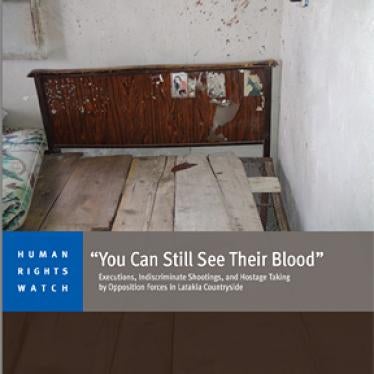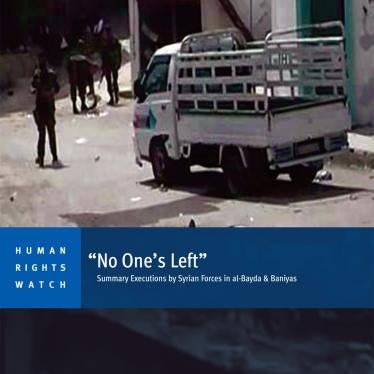(New York) - The United Nations should set up an international inquiry into the fatal shootings by Syria's security forces of peaceful protesters, Human Rights Watch said today after the killing of protesters in 14 separate towns on April 22, 2011. The inquiry should also examine other human rights violations committed since anti-government protests began in mid-March.
The US and European Union should also impose sanctions on Syrian officials who bear responsibility for the use of lethal force against peaceful protesters and the arbitrary detention and torture of hundreds of protesters, as well as request an urgent briefing of the UN Security Council on the spiraling situation in the country, including shootings on April 22.
"After Friday's carnage, it is no longer enough to condemn the violence," said Joe Stork, deputy Middle East director at Human Rights Watch. "Faced with the Syrian authorities' ‘shoot to kill' strategy, the international community needs to impose sanctions on those ordering the shooting of protesters."
On April 22, Syria's security forces killed at least 76 protesters, and possibly as many as 112, according to lists compiled by local human rights activists. Human Rights Watch interviewed protesters in the towns of Homs, Ezraa, Douma, and Maadamiya, who reported that security forces opened fire on them without warning. On April 23, security forces shot at funeral processions in Barza, Douma, and Ezraa, killing at least 12 additional mourners, according to media reports.
UN Secretary General Ban Ki-moon, US President Barack Obama, and Jerzy Buzek, president of the European Parliament, issued strong condemnations of the April 22 shootings, calling on the Syrian authorities to stop using violence against peaceful protesters, but did not press for any concrete actions.
The highest number of casualties was in Homs, the southern town of Ezraa, and in towns surrounding Damascus.
Homs
A Homs-based activist told Human Rights Watch that protests took place in at least four neighborhoods of the city: Bab al-Seba`, Bayyada, Khalidiyyah, and Baba al-`Amr. Syrian activists published a list of 19 names of killed protesters. One witness who joined the protest that started from the Nour Mosque in the Khalidiyya neighborhood told Human Rights Watch that around 2:30 p.m., security forces opened fire on them without any warning. He identified those shooting as security forces wearing uniforms as well as men in civilian clothes carrying Kalashnikovs. He saw a number of protesters shot, but was able to identify only one of those killed, Muhammad al-Kaheel.
Syria's state news agency, SANA, reported that a policeman was killed in Homs but provided no further details.
A doctor working at al-Barr Hospital in Homs, told Human Rights Watch on April 22 that by 4:30 p.m., the hospital had received four people killed during the demonstrations. The hospital's medical staff was also treating 15 wounded, two of them in critical condition. He said:
The hospital's five operating rooms are occupied. Most of the patients have bullet wounds to the chest. All the bullets are real. No rubber bullets at all. Protesters and neighbors are standing around the hospital to prevent security forces from entering and taking the wounded - like we heard happened in other hospitals.
Ezraa
Security forces also killed at least 18 protesters in the town of Ezraa, near the southern city of `Adra, according to Syrian human rights activists. A doctor in Ezraa's hospital told Human Rights Watch that by 4 p.m. on April 22, the hospital had received 12 bodies of killed protesters, including one who was about 10 years old. Another doctor at the Ezraa hospital said at 4:30 p.m. on April 22 that three of the wounded were in very critical condition and would likely die. He also indicated that he knew of one protester from the neighboring town of al-Hrake who was transferred to the national hospital in Daraa and died there.
Two Ezraa protesters interviewed by Human Rights Watch on April 22 said that they started their march from the Serail square. When they got close to the town's grain factory, security forces posted on the top of the factory opened fire on them. Both protesters said that they were peacefully marching and had not attacked the security forces. One of the protesters indicated that those shooting were wearing military clothes.
An official in the Syrian army told SANA that a group of individuals on motorbikes and in cars drove towards the center of Izraa and attacked guards at an official building, first with rocks and later by firing gunshots, which led the army to fire back. The official then spoke of "a car with masked gunmen who opened fire indiscriminately killing eight people." The two Ezraa protesters both denied categorically the allegations on SANA.
"If Syrian officials want the world to believe them, they must allow independent journalists and activists into the country," Stork said.
Damascus and Towns Nearby
Security forces were heavily deployed in Damascus and in the surrounding towns of Maadamiyya, Daraya, Douma, and Qaboun. A student at Damascus University described what he saw on April 22 in Zablatani, a central area of Damascus:
At about 2:30 p.m., I saw in Zablatani 11 green buses full of plainclothes security men armed with automatic weapons, tasers, and batons. I also saw "public committees" of residents with sticks guarding their blocks against what they consider intruders. Altogether, there were about 5,000 men there. The whole area was blocked off, no buses or taxis were allowed to pass through. At one point, they all began running toward one of the market areas. Near the area, I saw them beat and arrest someone, who was bleeding from the face. Another security agent was kicking a man in a corner. ... I heard shots being fired, but could not identify where or by whom.
A resident of Maadamiya, a town near Damascus where anti-government protests had occurred in past weeks, told a Human Rights Watch researcher by phone that security forces killed eight protesters there on April 22. The researcher could hear heavy gunfire while speaking to him around 3:45 p.m. local time. The Maadamiya resident said:
The army was deployed around the town since the previous evening. They belonged to the Fourth Unit. After midday prayer, we started a protest and reached the intersection for [the road to] Darya. The protest was peaceful with people chanting slogans calling for freedom and in some cases for the removal of the regime. At around 2:45, they suddenly opened fire on us without warning. I saw three die in front of me. My brother was injured, and my cousin died. We tried to take the wounded to the Darya hospital but were told that they were arresting the wounded and those bringing them. So we took the wounded to the Rawda Mosque. When we got there, there were already around 10 wounded being treated in the mosque.
"President Bashar al-Asad's promises of reform mean nothing while his security forces are free to kill peaceful protesters," Stork said. "The Obama administration and the EU should push for meaningful sanctions that will persuade President Asad to end the shootings and restore human rights."






